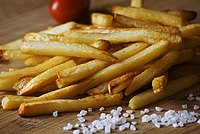
Photo from wikipedia
Fried snacks are highly appreciated in the consumer's diet because of their unique flavor and texture. However, it is difficult to combine fried foods with the current consumer trends toward… Click to show full abstract
Fried snacks are highly appreciated in the consumer's diet because of their unique flavor and texture. However, it is difficult to combine fried foods with the current consumer trends toward healthier and low‐fat products. Vacuum frying is a healthier option to develop snacks with differentiated nutritional and organoleptic properties. However, pretreatments are required to obtain products with better properties. This study investigated the effect of processing (whole, peeled, peeled, and sliced) and pressurization (100, 200 and 300 MPa) prior to vacuum frying. The study showed that peeling and slicing, prior to pressurization, produced microstructural stress which affected significantly moisture and oil uptake; meanwhile, pressurization pretreatment in whole apples did not produce any negative effects, thus enhancing the textural properties of the vacuum‐fried product. PRACTICAL APPLICATIONS: Vacuum frying has a potential to produce healthy snacks. In order to obtain fried fruits, pretreatments are required, which enable the production of products with adequate sensory qualities. The use of HPP in fruits has not been investigated as a pretreatment prior to vacuum frying. This study investigates structural and mechanical effects of processing (whole, peeled and peeled and sliced) and pressurization (100, 200 and 300 MPa) prior to vacuum frying. These factors play an important role in the snack microstructure and oil uptake. Results showed that HPP applied on whole or peeled apples at low pressures (100 and 200 MPa) enhanced the textural properties before frying. HPP can be a feasible alternative to osmotic pretreatments, considering additional advantages, such as improving the nutritional composition of the final product.
Journal Title: Journal of Food Processing and Preservation
Year Published: 2019
Link to full text (if available)
Share on Social Media: Sign Up to like & get
recommendations!